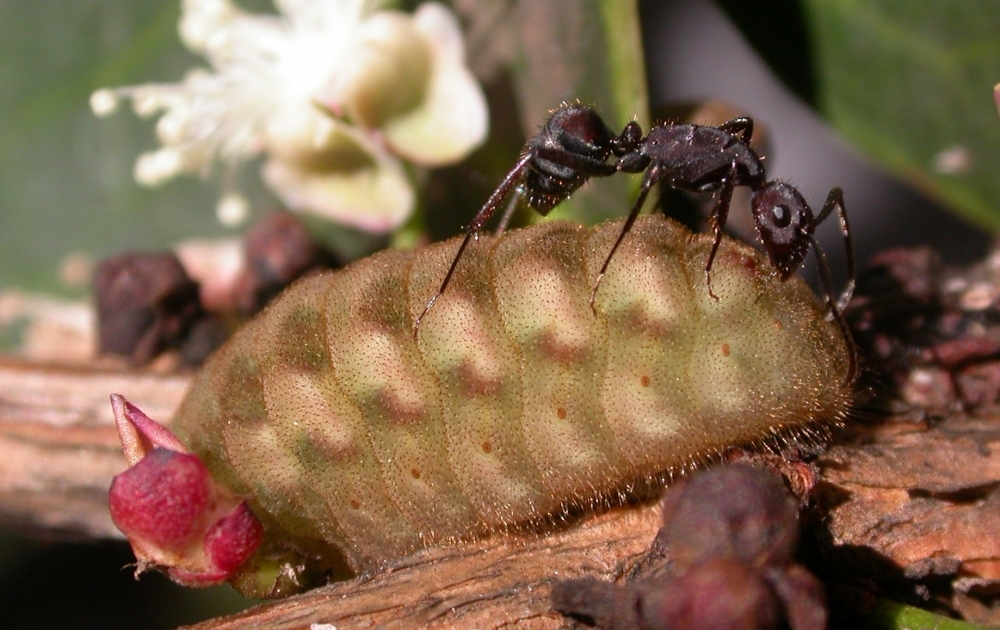

Study reveals different forms of interaction between insect groups: while some caterpillar species have bodies covered with molecules identical to those of the plants they inhabit and are ‘invisible’ to ants, others offer ants nectar in exchange for protection from predators (interaction between a caterpillar of the species Parrhasius polibetes and an ant of the species Camponotus leydigi; photo: Lucas Kaminski / UFRGS)
Study reveals different forms of interaction between insect groups: while some caterpillar species have bodies covered with molecules identical to those of the plants they inhabit and are ‘invisible’ to ants, others offer ants nectar in exchange for protection from predators.
Study reveals different forms of interaction between insect groups: while some caterpillar species have bodies covered with molecules identical to those of the plants they inhabit and are ‘invisible’ to ants, others offer ants nectar in exchange for protection from predators.

Study reveals different forms of interaction between insect groups: while some caterpillar species have bodies covered with molecules identical to those of the plants they inhabit and are ‘invisible’ to ants, others offer ants nectar in exchange for protection from predators (interaction between a caterpillar of the species Parrhasius polibetes and an ant of the species Camponotus leydigi; photo: Lucas Kaminski / UFRGS)
By André Julião | Agência FAPESP – For a caterpillar that lives surrounded by ants, there are two ways of avoiding attack: going unnoticed or offering the ants a sugary treat in exchange for protection. This is the main conclusion of a study funded by FAPESP and published in Ecological Entomology.
Based on chemical analysis of interacting plants, caterpillars and ants, researchers in Brazil affiliated with the Federal University of Rio Grande do Sul (UFRGS) and the University of Campinas (UNICAMP) found that some caterpillars are chemically very similar to the plants on which they live and feed and that this helps them hide from ants. However, there are chemically different species that have developed a strategy of coexistence through the production of a caloric reward for the ants.
“Ants prey on many insects that live on plants and establish mutualist interactions that benefit both ants and plants. To live on plants that have ants, caterpillars develop strategies that enable them to coexist with the ants. There are many advantages to living near ants. Many ants are aggressive and limit the occurrence of certain organisms. So if any animal is able to live close to ants without being attacked by them, it may acquire an adaptive advantage,” said Lucas Augusto Kaminski, a researcher in UFRGS’s Zoology Department and principal investigator for the study.
He did part of the research during a postdoctoral internship at UNICAMP’s Institute of Biology with a scholarship from FAPESP and collaboration by José Roberto Trigo, a professor at the institute who died in 2017 and was also supported by FAPESP. The first author of the article is Luan Dias Lima, who performed the other part of the research while studying for a doctorate at UFRGS.
Selective pressure
In the 2000s, Trigo published scientific articles that showed how cuticular hydrocarbons (CHCs) come under selective pressure from ants. CHCs cover the cuticle (outermost layer) of virtually all insects and plants, serving as a waterproofing agent and communication signal. Ants have limited vision and perceive the world chemically, via their feelers or antennae. Some species of caterpillar and insects like leafhoppers have evolved so as to present the same CHCs as the plants on which they live, and ants do not perceive them as different from the plants, unwittingly protecting them against attackers. This type of relationship can be classified as commensalism – beneficial for the caterpillar and neutral for the ant.
In the latest study, the researchers used mass spectrometry and gas chromatography to compare CHC composition in six caterpillar species, three plant species, and two ant species. The caterpillars were all myrmecophilous (“ant-loving”).
The results of the analysis showed about 95% similarity in caterpillar and plant CHCs in most cases, and no similarity with ant CHCs. The conclusion had to be that chemical camouflage was involved. This was as the researchers expected. However, in some cases, the similarity was much lower, between 34% and 55%, so that the caterpillars concerned must be entirely “visible” to ants.
“This information apparently led nowhere,” Kaminski said. The researchers now had an insight: What if the very conspicuousness of these species was an evolutionary advantage? Then they noticed another difference.
Some caterpillars are known to have organs dedicated to interacting with ants, such as structures that produce substrate vibrations and minute bristles (setae) used in chemical communication. Other key organs include glands that produce a sugary liquid as a caloric reward for ants.
In camouflaged species, production of this “nectar” was scant or the glands were inert. In conspicuous species, these organs were well-developed and produced a significant amount of the fluid.
“If a caterpillar stays hidden, it doesn’t need to give ants anything, but if it produces a reward it must be conspicuous. What’s involved here is the evolution of the caterpillar’s communication with the ant,” Barbosa said.
According to the authors, these characteristics may lead species with nectar-producing glands to become more and more chemically similar. The phenomenon is known as mimicry and is common among insects.
Resembling a poisonous or reward-giving species, for example, may be an adaptive advantage. The researchers now propose that a kind of reward-based mimicry may also occur in chemical terms.
The article “Chemical convergence between a guild of facultative myrmecophilous caterpillars and host plants” can be retrieved from: onlinelibrary.wiley.com/doi/abs/10.1111/een.12941.
Republish
The Agency FAPESP licenses news via Creative Commons (CC-BY-NC-ND) so that they can be republished free of charge and in a simple way by other digital or printed vehicles. Agência FAPESP must be credited as the source of the content being republished and the name of the reporter (if any) must be attributed. Using the HMTL button below allows compliance with these rules, detailed in Digital Republishing Policy FAPESP.





